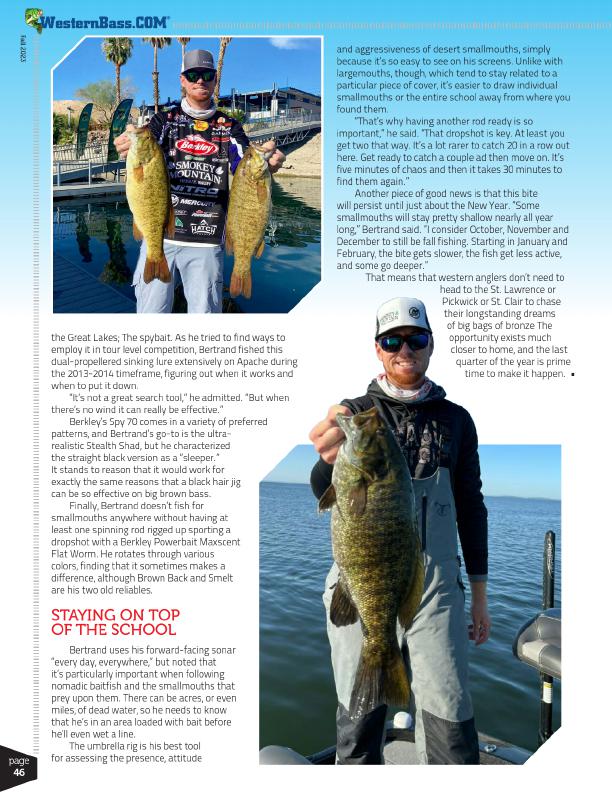
®
Fall 2023
page 46
the Great Lakes; The spybait. As he tried to find ways to employ it in tour level competition, Bertrand fished this dual-propellered sinking lure extensively on Apache during the 2013-2014 timeframe, figuring out when it works and when to put it down.
“It’s not a great search tool,” he admitted. “But when there’s no wind it can really be effective.”
Berkley’s Spy 70 comes in a variety of preferred patterns, and Bertrand’s go-to is the ultra- realistic Stealth Shad, but he characterized the straight black version as a “sleeper.” It stands to reason that it would work for exactly the same reasons that a black hair jig can be so effective on big brown bass.
Finally, Bertrand doesn’t fish for smallmouths anywhere without having at least one spinning rod rigged up sporting a dropshot with a Berkley Powerbait Maxscent Flat Worm. He rotates through various colors, finding that it sometimes makes a difference, although Brown Back and Smelt are his two old reliables.
STAYING ON TOP OF THE SCHOOL
Bertrand uses his forward-facing sonar “every day, everywhere,” but noted that it’s particularly important when following nomadic baitfish and the smallmouths that prey upon them. There can be acres, or even miles, of dead water, so he needs to know that he’s in an area loaded with bait before he’ll even wet a line.
The umbrella rig is his best tool for assessing the presence, attitude
and aggressiveness of desert smallmouths, simply because it’s so easy to see on his screens. Unlike with largemouths, though, which tend to stay related to a particular piece of cover, it’s easier to draw individual smallmouths or the entire school away from where you found them.
“That’s why having another rod ready is so important,” he said. “That dropshot is key. At least you get two that way. It’s a lot rarer to catch 20 in a row out here. Get ready to catch a couple ad then move on. It’s five minutes of chaos and then it takes 30 minutes to find them again.”
Another piece of good news is that this bite will persist until just about the New Year. “Some smallmouths will stay pretty shallow nearly all year long,” Bertrand said. “I consider October, November and December to still be fall fishing. Starting in January and February, the bite gets slower, the fish get less active, and some go deeper.”
That means that western anglers don’t need to
head to the St. Lawrence or
Pickwick or St. Clair to chase
their longstanding dreams
of big bags of bronze The
opportunity exists much
closer to home, and the last
quarter of the year is prime
time to make it happen. •